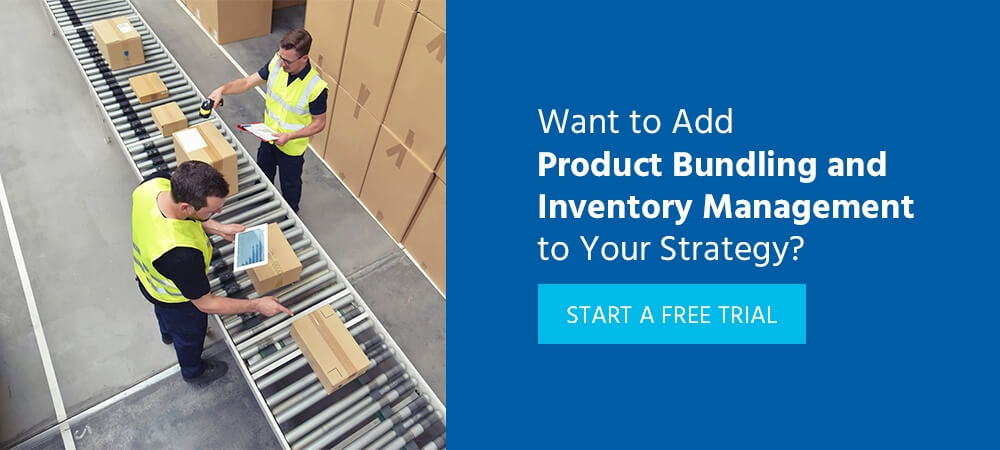Product Kitting and Bundling
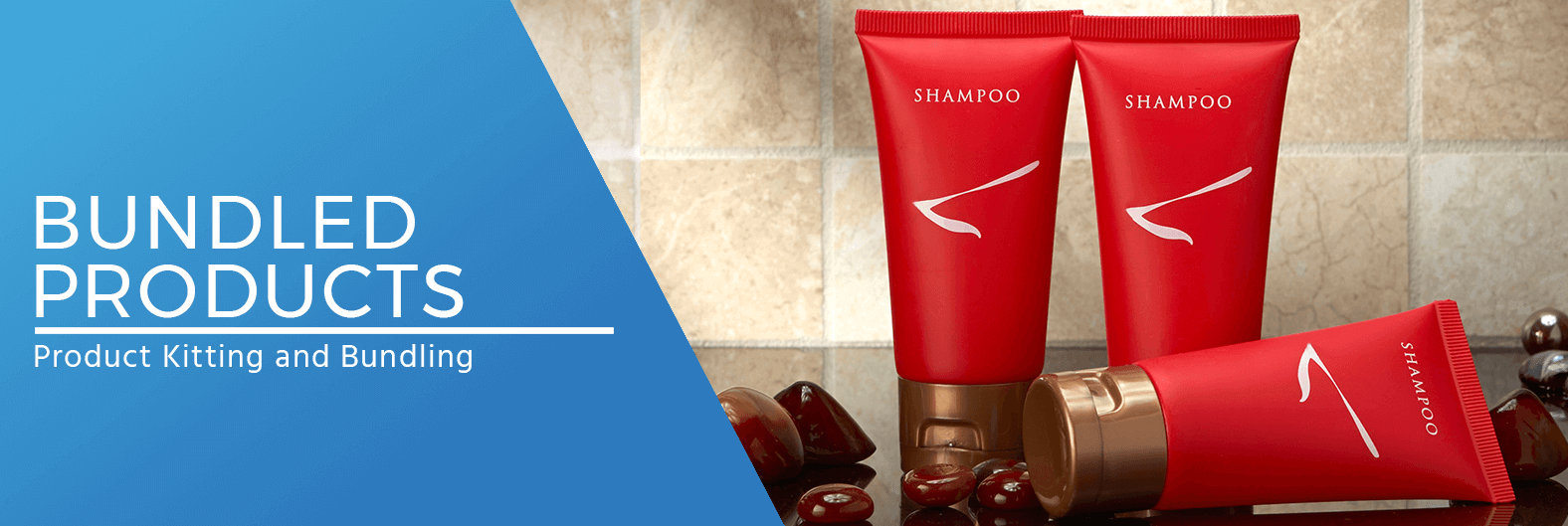

What Is Product Bundling?
Product bundling, also known as kitting, is a technique where items are “bundled” together as one product listing. This process groups several products together and packages, ships and sells them as a single unit for a single price that is typically lower than the cost of purchasing each item individually. These items are usually grouped by a thematic pattern where the items are related to one another.
One common example of a bundle in action is the classic fast-food meal. Most fast-food meals include a burger, french fries and soda. While customers could buy these items separately, the restaurant offers a bundle in the form of a meal, which encourages customers to buy the entire combination.
In retail operations, product bundling relies on a similar strategic thought process. For example, imagine a company that sells bath supplies is putting together a bundle box. In this box, the company might put items like shampoo, conditioner, bath bombs, face creams and other similar items to build a kit that provides the user with a few products to use in the bathroom. The contents of the box will be up to you, though the items should probably be related in some way.
Companies can also create more targeted inventory bundles. For example, the bath supply company might focus on providing several face creams and cleansers or create a box with only items featuring a certain ingredient. Instead of trying to cover every base, they can make the theme very focused and brand it as such. Determining whether to provide general or specific bundles or both will depend on what a company thinks their customers’ needs are.
Product Bundling Tutorial Video
How Does Product Bundling Work?
In real-world applications, selling using the inventory bundling and kitting process works just as easily as selling individual items. When a customer orders a bundle, inventory is automatically deducted from each item in the bundle. This makes it very easy to sell the items separately while also offering them together as a bundle.
For example, if you sell a suitcase and a tote individually, you could also offer a "weekend warrior" bundle of the suitcase and the tote. With a product bundling and inventory kitting software like Finale Inventory, if you sell the "weekend warrior" bundle, Finale would automatically deduct one suitcase and one tote from inventory.
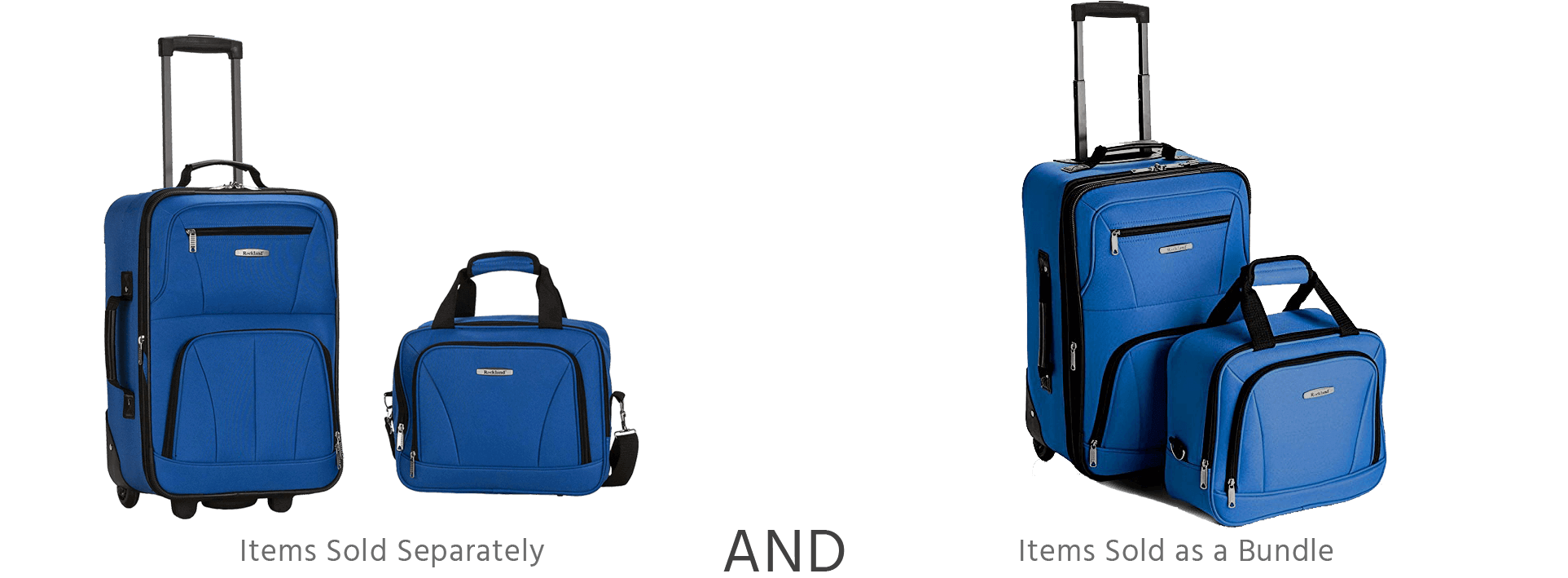

Alternatively, if you were to sell one suitcase or one tote separately, your bundling and kitting software would also update the overall quantity available for the "weekend warrior" bundle, ensuring that all listings are in sync with an accurate stock level of what can be sold based on all of the stock levels for the items within a bundle.
In this example, your physical stock levels would only be tracked at the individual product level. Finale Inventory would always be able to tell you how many bundles could be sold, but you would not physically have stock of the bundle itself, only of each item within the bundle.
This video tutorial will demonstrate how to create a product bundle within Finale. Additionally, it will also provide a demonstration of the use of kits while processing an order with our ShipStation integration to illustrate how inventory levels are impacted.
Bundling Products With Finale Inventory
Finale Inventory understands the appeal of product bundles and how it can impact a business positively. Our inventory management software comes with bundling functionality to help you manage the creation and sales of bundles and kits.
Creating a product bundle is quick and easy with Finale Inventory. The whole process is done in a few short steps, detailed below:
1) Create child products by assigning a product ID to each component, such as a shampoo and conditioner bottle.

2) Create a parent product ID for the bundle. For example, create an ID for a kit containing the shampoo and conditioner bottles.

3) Click on the bundled product to get access to the product details page and scroll toward the bottom of the page to see the Bill of Materials module.
4) With the bill of materials, list the child part numbers contained in the kit. In this example, the child products are one bottle of shampoo and one bottle of conditioner.

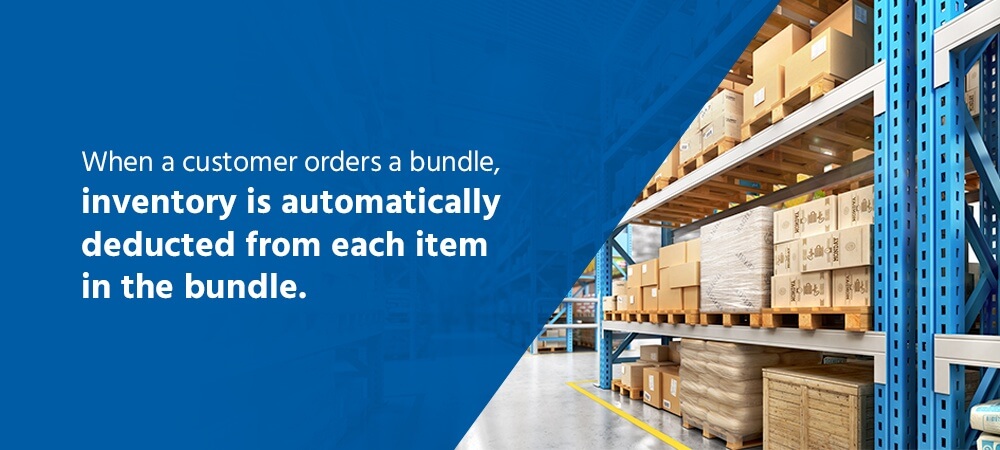

Importance of Product Bundling and Kitting
Product kitting and bundling may seem like an interesting idea, but what does it mean for your company? If you’re not convinced that product bundling is worth implementing, you should first consider its many benefits. Warehouse bundling is a powerful marketing tool that positively affects companies at every level. The following are several benefits that come with product bundling, no matter what industry you are in:
Everyone loves a good deal, and product bundles give people the feeling that they are getting more bang for their buck. These consumers are usually justified in their feeling, as it’s common practice for the individual items sold in these boxes to be sold at a lower cost. In comparison to buying each item individually, bundled items will be significantly cheaper.
Kitting provides a significant amount of value to customers, and they can increase sales for companies as well. Though companies will be selling their items at a lower price, the popularity of bundled products will often lead to an increase in the volume of sales and the average order value. This, in turn, generates larger profits.
Another way that bundling can positively impact your sales is by bundling lesser-known or less-popular products into a kit that customers are likely to buy. Merchandise that isn’t sold stays in your inventory as dead stock, increasing holding cost and potentially turning into waste. By bundling these items with more popular items and including the price of the less-popular product in with the cost of the bundle, you can encourage customers to purchase the bundle, helping you move inventory and minimize wasted warehouse space or product.
Additionally, if you’ve had trouble marketing a product, but you believe that it can provide a customer with plenty of value, bundling it into a kit will give it an opportunity to make an impression on the customer. After a customer has used the product, they may be more likely to purchase it on its own in the future, making the bundle an excellent marketing device that can lead to more individual sales in the future.
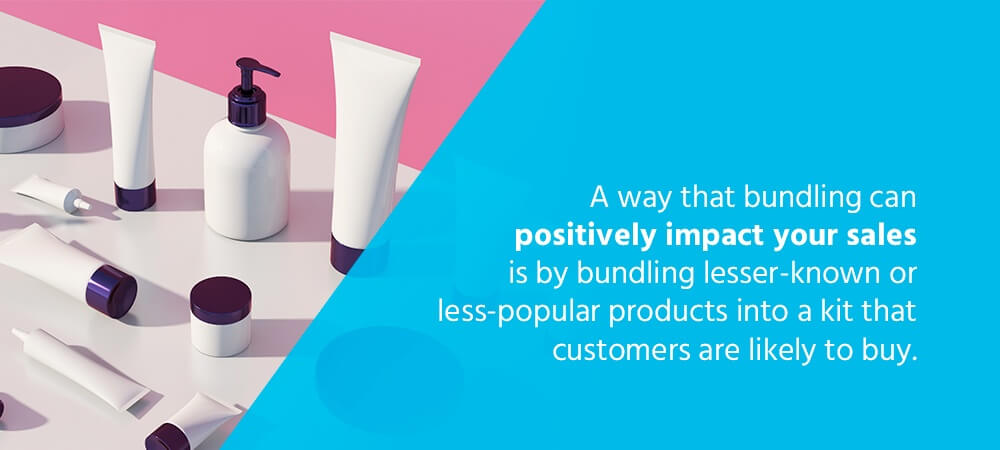

Types of Products Bundling
If you are considering adding bundles to your product offerings, you should know about the common types of product bundles and product bundling strategies that are popular today. The following are the most common types of product bundling:
Packed-to-Order Bundles
One prominent example of product bundling is packed-to-order sets. For example, if you sell bathroom towels, instead of selling a single towel, you might package a few towels into a set. In this set, you could include another towel, a hand towel and a washcloth. If a customer is trying to give their bathroom a consistent aesthetic, buying a set of different kinds of towels and cloths can pull together an entire bathroom.
Sets are extremely popular in online sales, and customers enjoy that bundles make the buying process easier and faster. Bundling products in this way also can lead to increased sales as you can offer discounts for group sales and sets.
Subscription Boxes
Subscription boxes are one of the hottest bundling options on the market right now. Unlike what comes with packed-to-order sets, the items that arrive in a subscription box will often be a surprise. However, some companies offer customizable subscription boxes where customers can view the contents before it’s shipped.
In these boxes, you’ll find plenty of different products all fit into one package. These boxes can be very lucrative for companies as customers will often sign up for plans where they pay for and receive a box monthly, giving the company a steady stream of revenue.
Assembled Product Bundles
Another form of bundling is when a larger item, like a bike, is shipped in separate parts to a consumer or to other sellers. For sellers who don’t have the staff or equipment to sell products preassembled, selling separate parts to make up an entire product in one package can be invaluable.
The packaging of multiple parts can also be used to sell a variety of different versions of a product. For example, a company could offer one version of a product with standard parts, while another version could be offered that contains upgraded portions of the product that might better fit a customer’s specialized needs.
New Product Bundling
New product bundling is a technique where newly-launched products are strategically bundled with popular related products as a promotion. This is a great way to introduce customers to the latest product offerings without increasing as much spending on marketing.
This bundling method is commonly used by online stores and markets that rely heavily on online sales. A great example is in the video game industry, where consoles are often sold with new console-specific titles and games are released with themed gaming accessories.
Mix-and-Match Bundles
Also known as custom bundles, the mix-and-match bundling technique allows customers to create a bundle from multiple similar products. With this technique, the company specifies a list of products that customers can bundle together. This method helps the customer feel like they are in control of what they buy, which in turn increases the perceived value of the items and the bundle as a whole. Research suggests that 80% of customers are more likely to purchase offers simply because they are customized.
A popular example of this is meal delivery services, where customers can choose a limited number of recipes from a weekly or monthly menu. Another example in retail is where customers can select any outfit from a limited collection for a fixed price.
Cross-Sell Bundles
This bundling technique involves retailers selling complementary products as add-ons for a primary product. This bundling is often used to sell items that are commonly purchased together or to sell accessories for more expensive products.
A good example of this is in the tech industry with phone sales. Smartphones are often purchased with cases, so sellers may offer a bundle where purchasers of a new smartphone can buy a case at a discounted rate.
Gift Bundles
As previously discussed, gift bundles are a popular option because of the convenience offered to customers. These bundles are aimed at customers who wish to give a gift and may not know exactly what the recipient wants, but they know what they like.
Gift bundles often offer a range of products related to a theme. For example, skincare brands often develop gift bundles around the holidays centered around different themes and aimed at different target audiences. Skin care bundles for male grooming, perfume sets for women and even nail polish kits for children are often sold around the holidays.
Inventory Clearance Bundling
This bundling technique involves pairing fast-moving items with slow-moving items to clear inventory space. This method offers a discount for the fast-moving product that attracts buyers and increases the chances that they will purchase the bundle to get more value on the dollar.
For example, if a store finds that their coffee makers are selling very well, but a specific brand of coffee isn’t moving as quickly as they had hoped, they could offer a bundle pairing a new coffee maker with a bag of the less popular coffee brand.
Buy-One-Get-One Bundles
Buy-One-Get-One or BOGO bundling involves selling the main item and offering a discount for another complementary product. This technique is often used to sell one-time-purchase products or specialty items that consumers don’t buy as frequently.
A common example is in retail. Stores will often offer BOGO sales to encourage shoppers to buy more of a specific type of item, such as dress pants, shirts or shoes. The discounted price on a second item encourages shoppers to buy more than they normally would.
Strategies to Improve Customer Satisfaction
When you make bundling a part of your company, you'll want to try to improve customer experience and satisfaction continuously. Below are a few additional strategies you can use to increase satisfaction among your customers:
- Personalized products: Along with offering custom orders, you can take it a step further by offering personalized products within kits. A personalized product may have the customer's name inscribed on it or have a custom image or message included on one of the products. Adding some personalization to your bundle makes the kit even more attractive to customers.
- Giveaway bundles: Customers love free stuff, and a giveaway bundle is a great way to improve customers' satisfaction. Offer these bundles to customers in raffles that they have to sign up for or give them away as a reward once the customer reaches a certain number of purchases. Though you won't make money on these bundles, they are a great way to improve customer loyalty.
- Sample bundles: If you want to try to get your customers to try out your new products and improve their view of the company, you can do so with free sample bundles. With these kits, you can send them smaller versions of your products to give them a taste of your current offerings. This sort of bundle can attract new business while also making customers feel valued.
Always remember to offer bundles as an option, not as the standard. Researchers reviewed sales data on video game consoles, and they found that sales improved when companies offered bundles as well as the option to purchase games and consoles separately. However, when companies only gave consumers bundle options, revenues decreased by over 20%. The perception of choice is a large driver for consumers, and their ability to compare prices and see their savings in action is a key factor in the success of bundles.
What Is Product Bundling Pricing
While knowing what types of bundles you can offer is important, it is essential to understand how to set your product bundle pricing. What price you set for your bundles can play a major role in the successes of these bundles. Keep these points in mind:
- Know your audience: Leverage your knowledge of your customer base and consumer data to identify purchasing trends. This will allow you to create bundles that are attractive to customers and get an idea of what customers believe to be acceptable prices.
- Don't go too low: Put thought into your bundle prices. Bundles should be priced lower than the sum of the individual products when sold seperately. Otherwise, there is no point to the bundle. However, the discount shouldn't be so low that the products appear cheap.
- Align with your brand: Keep your prices competitive in the market by aligning them with the reputation of your brand. If you are a discount brand, you can likely go lower with the bundle cost than premium brands.
- Keep sustainability in mind: The price of the bundle should be sustainable when you consider your company's costs. Bundles are created to improve profits, not losing money.
- Market the bundle: Bundling marketing is an essential part of the success of a bundle. So what is bundle pricing in marketing, and what does it look like? If you store sends our flyers or emails, announce the bundle and the savings it offers. Label the bundle clearly on signs and use the discount to your advantage.
Setting bundle prices may take some market research and even trial-and-error, but when you find the sweet spot, you can enjoy all the benefits bundles have to offer.
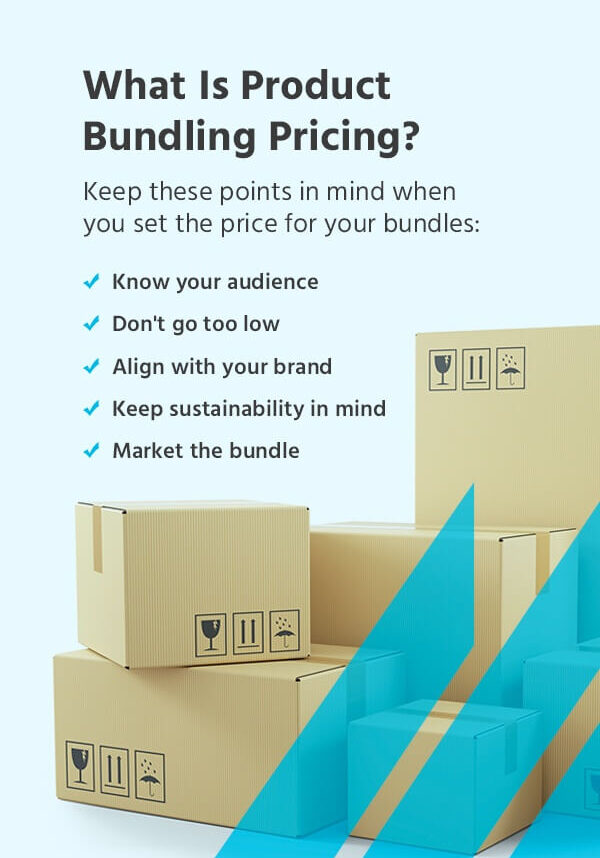

How Inventory Management Software Can Help With Bundling and Fulfillment
Product bundling is an effective tool to move large amounts of inventory, make more money and cut down on costs. To make this process run as smoothly and efficiently as possible, you can use inventory management software.
With Finale Inventory's software, you can increase the number of listings within your online selling channels by crafting kits and bundles to create a new product. After you've finalized your product bundling strategy and set up bundles in the system, the software will also help process the orders. As the bundles consist of individual products that have their own SKUs, a software system will help keep track of products and parts being removed from inventory.
It also makes it easy to set up and keep track of kits that are only going to be offered for a set amount of time. For example, your company might want to put together a holiday deal that will attract new business. With the software, you can quickly combine products and keep track of any sales in the system.
Want to Add Product Bundling and Inventory Management to Your Strategy?
If you’re ready to add product bundling to your business strategy, you should pair it with an inventory management system to make it as efficient as possible.
Before you commit, you can sign up for a free trial of Finale Inventory’s software. As you try the program, consider reviewing which plan is right for your company. If you have any questions, contact one of our trusted representatives at 888-792-8891.





